Watteau’s Forgotten Friend: Jean Nicolas de La Hire
© Martin Eidelberg
Created May 2020
© Martin Eidelberg
Created May 2020
Despite Watteau’s death in September 1721, the art of the fête galante continued forward. A number of painters, perhaps less inventive but nonetheless skillful, continued to produce fêtes galantes in the style of their master. The most obvious practitioners included Jean-Baptiste Pater, who had come back to work with Watteau in 1720. There also was Nicolas Lancret; he had worked briefly in Watteau’s studio, was already active as an independent artist in the late 1710s, and was accepted into the Academy in 1719 as a “peintre de fêtes galantes.” A third was Bonaventure de Bar, who was actively painting fêtes galantes in Paris until his premature death in 1729. Antoine Quillard was working in Paris in the years before and after 1720, but then went to Lisbon in 1727. There are also fêtes galantes from this period but we do not yet know the names of their painters, for example, those I have called the Sieste Master and the Nantes Master. Yet one more person to be added to this group is Jean Nicolas de La Hire. His is not a familiar name. To the contrary, it is essentially unknown. Indeed, except for two paragraphs in Dacier, Vuaflart and Hérold’s monumental four volumes on Watteau published a century ago, we would be hard put to say anything about him.1 Yet, we can gather together a number of La Hire’s works, and explore his association with Watteau. This sheds new light not only on La Hire but also on Watteau and the circumstances of his world.
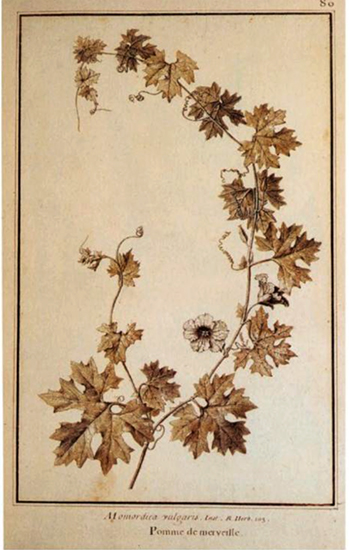 |
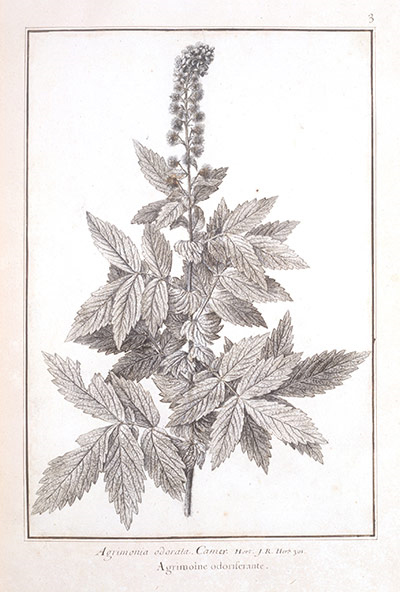 |
1. Jean Nicolas de La Hire, Balsam Apple Vine, partially colored nature print. Vienna, Österreichische Nationalbibliothek, Handschriftensammlungen. |
2. Jean Nicolas de La Hire, Church Steeple (Agrimonia odorata), partially colored nature print. Vienna, Österreichische Nationalbibliothek, Handschriftensammlungen. |
La Hire (or La Hyre), born in Paris on July 28, 1685, was the son of the famous mathematician Philippe de la Hire and thus was destined for the world of science. Indeed, he studied medicine and in 1711 was appointed to the faculty of the Académie royale des Sciences. This knowledge comes from Pierre Jean Mariette, our principal source of information about the man.2 In addition to his interest in medicine, La Hire had a natural talent for drawing and made studies of plants, hoping to form a corpus of all known species. He invented a process, still not fully understood today, in which he pressed the actual plant specimens on paper, rubbed the prints with white pigment, reinforced the lines, and then hand colored the images (figs. 1, 2). His preoccupation with this project was not looked upon with approval by the Academy. This caused La Hire to leave that august body, never to return, and he carefully took his botanical studies with him. Mariette reported that La Hire gave many to Prince Eugène of Savoy; later these found a place in the Royal Library in Vienna. Also Mariette was given six plates, which were subsequently sold with his collection.3
Although La Hire returned to the study of medicine, in his spare moments he continued to exercise his artistic skills. In particular, he executed drawings and gouache paintings in the style of Watteau. In Mariette’s words:
Seulement, dans les moments qu’il auroit pu donner à la récréation, il prenoit, pour se délasser, le crayon et le pinceau, et peignoit à gouazze des paysage et de petits sujets de modes d’après le goût de Vateau. . .
Mariette’s term of “petits sujets” was his way of saying “fêtes galantes,” since today’s term did not come into general usage until the mid-nineteenth century.4
Mariette had only words of praise for La Hire’s art, and that constitutes high praise, given its source: “Il avoit en effet le tact sûr, une connoissance fort étudié de la couleur et du clair obscur; il en sçavoit faire une heureuse application.” To a degree, Mariette’s praise may have been colored by his deep friendship with La Hire but surely there was some truth to what he wrote.
We no longer have first-hand proof of La Hire’s skill since nothing from his hand seems to have survived. His self-portrait, a black and white chalk drawing which he gave to Mariette, was last seen in 1799.5 A small gouache study of a nurse and her child was in the noted collection of Blondel de Gagny; when it later sold, its author was referred to as “La Hyre le Médecin,” an interesting appellation.6 None of La Hire’s gouache landscapes have survived, nor have his fêtes galantes. But there are descriptions of some of the fêtes galantes, and three engravings after his compositions provide much-needed visual evidence. Together, this documentation affords us some insights into his art.
Nine of La Hire’s gouache paintings were in the collection of Gilbert Paignon-Dijonval, an encyclopedic collection formed in the second half of the eighteenth century and which included works by obscure masters.7 The nine gouaches were mistakenly listed under the name of Jean Nicolas’ father Pierre, a famous mathematician who also was a skilled artist, but the text make it clear that the works are by Jean Nicolas.
3192. Une compagnie en conversation dans une campagne; autre assemblée où l’on voit un homme et une femme dansant sur l’herbe au son de la guitare; les figures sont dans le goût de Wateau: ces deux sujets sont peints à gouache; l. 8 po. sur 6 po.
3193. Autre sujet de conversation de cinq personnes au bord d’une rivière; h. 6 po. sur 5 po.
Autre de trois personnes près d’une rivière; on voit audelà un vieux château au haut d’un rocher: peint à gouache; l. 6 po. sur 5 po.3194. Quatre sujets de forme ronde; amusemens champêtres, balançoire, jeu de bague, etc.: à gouache sur vélin; l. 4 po. sur 4 po.”
The galante subjects are what we might have expected, as is the medium of gouache, but the surprise is their small scale. The last ones listed, all circular, are only 10.6 cm in diameter.
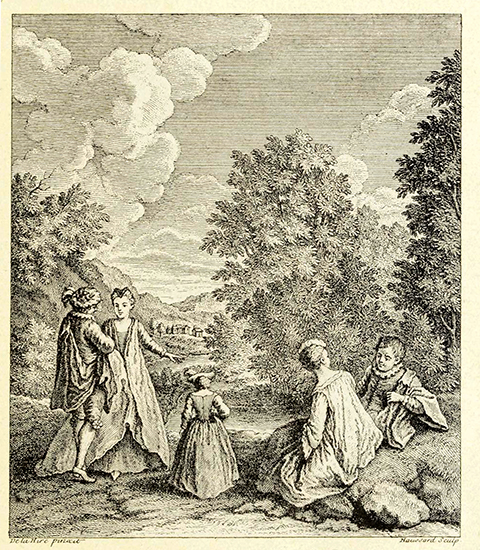 |
3. Jean-Baptiste Haussard after Jean Nicolas de La Hire, Amusements champêtres, engraving. Paris, Bibliothèque nationale, Département des estampes et de la photographie. |
Two engravings by Jean-Baptiste Haussard (1679-1749) in the collection of the Bibliothèque nationale afford us some idea of the appearance of La Hire’s pictures (fig. 3).8 The legends at the bottom left of the engravings proclaim, “De La Hire pinxit,” thus assuring us who designed these fêtes galantes.
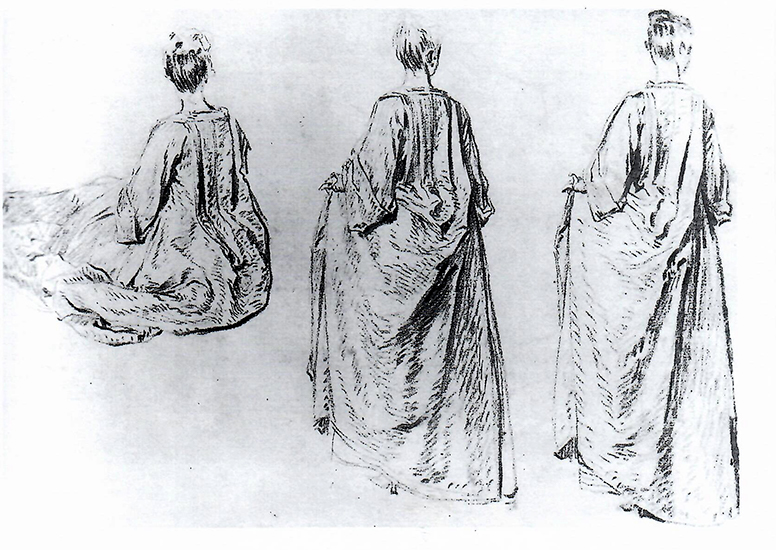 |
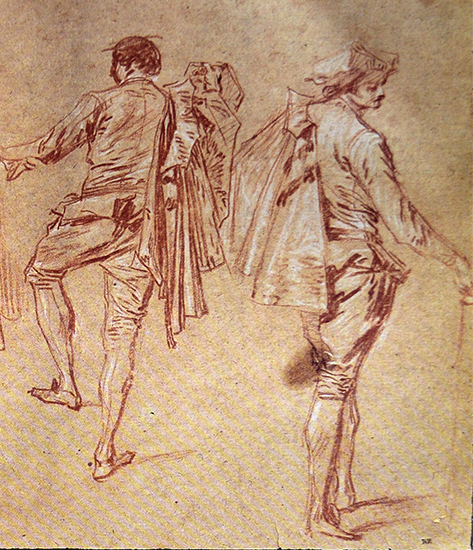 |
4. Watteau, Three Studies of a Woman, red chalk, 14.7 x 20.8 cm. France, private collection. |
5. Watteau, Four Studies of a Man with a Cape (detail), red and white chalk. Paris, Musée du Louvre, Département des arts graphiques. |
The four adults and child in the first of the engravings look very much as though they stepped out of Watteau drawings or a painting. The seated woman at the right, her back turned to us as she converses with her gallant male companion, closely resembles models drawn by Watteau, such as one in a French private collection (fig. 4), and similarly posed woman often appear in the foregrounds of Watteau’s paintings such as L’Île enchantée. So too the child at the center of La Hire’s composition turns her back to us, and looks off to the distance, very much in the spirit of Watteau. The man at the far left who cocks his head at an angle and lifts his cape so that it falls with artful cascades is the type of elegant male that populates Watteau’s fête galantes (fig. 5). While these figures correspond to Watteau’s art. their symmetrical arrangement is less interesting than Watteau’s skillful, more nonchalant groupings. Also La Hire’s trees are unlike the tall plumes of foliage found in Watteau’s picture. As much as La Hire may have emulated Watteau, he found his own style.
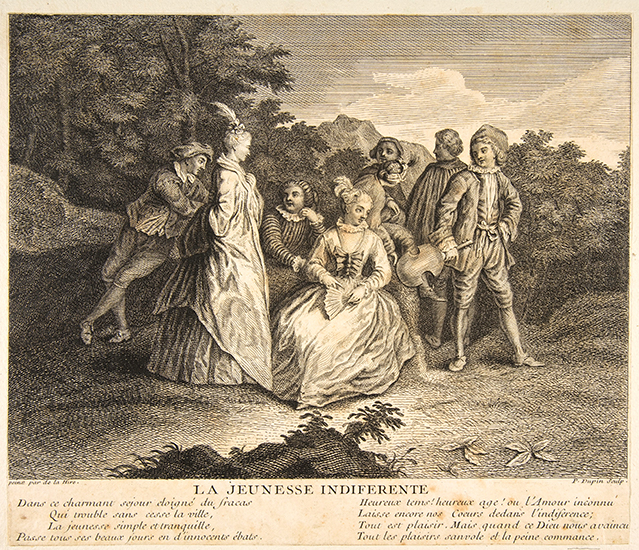 |
6. Pierre Dupin after Jean Nicolas de La Hire, La Jeunesse indifférente, engraving, 23.7 x 27.6 cm. New York, Metropolitan Museum of Art. |
A third engraving after a La Hire painting (fig. 6) is by Pierre Dupin (c. 1690-1751).9 Its legend declares at the lower left “peinx par de la Hire.” Although the composition is less refined than the previous example, this is probably not the fault of La Hire’s painting but, rather, Dupin’s weakness as an engraver. Other prints by him, especially his engraving after Watteau’s Le Départ pour les îles, show similar faults. In La Jeunesse indifférente, the characters’ strange smiles are like caricatures, and the poses are awkward. The nature of the composition is unlike Watteau’s: all the figures are compressed into a too tightly knit group without breathing space between the individual figures, yet an empty spaces is left at each side. This is definitely not a formula that Watteau ever used, nor does the landscape, which forms a dense screen across the background, have a counterpart in Watteau’s oeuvre. The actor at the left side, seated on a hillock, legs crossed, looks more like a figure borrowed from a painting by Lancret.
With only these few examples to consider, we must be wary of reaching overly firm conclusions. Nonetheless, these prints give us some idea of the range of La Hire’s “petits sujets de modes d’après le goût de Vateau.” Certainly he could work successfully in Watteau’s manner, but he was not a servile imitator and absorbed other strains of the new French art.
Before classifying La Hire as just another of what Robert Rey termed the “satellites of Watteau,” we should turn back to Mariette’s precious testimony. Apparently La Hire was not just an emulator of Watteau’s work from a distance but, rather, he and Watteau—each essentially the same age as the other—were friends. As Mariette described La Hire, “Il étoit lié d’amitié avec Vateau et avec une partie des meilleurs artistes. . . “ None of Watteau’s biographers mentioned their friendship, and modern Watteau scholars have likewise omitted any reference to La Hire. Not even Dacier, Vuaflart, and Hérold noted that the men were friends. One yearns to know what this friendship entailed. There are other unanswered issues, especially the question of who the other “meilleurs artistes” were.
As much as we may have thought we understood Watteau’s circle of friends and associates, there is much to learn. Even if we do not have all the answers, we now know better what some of the questions are.
NOTES
1 Émile Dacier, Albert Vuaflart, and Jacques Hérold, Jean de Jullienne et les graveurs de Watteau au XVIIIème siècle, 4 vols. (Paris: 1921-29), 1: 167.
2 Pierre Jean Mariette, Abecedario de P.J. Mariette et autres notes inédites de cet amateur sur les arts et les artistes: Ouvrage publié d’après les manuscrits autographes conservés au cabinet des estampes de la Bibliothèque impériale, et annoté par MM Ph. de Chennevièrs et A. de Montaiglon, 6 vols., (Paris: 1851-53; 1859-60), 3: 51-53.
3 Sale, Paris, collection of Pierre Jean Mariette, January 30 ff, 1776, lot 1433: “Autre Porte-feuille, contenant six feuilles de Plantes . . . par de la Hyre, Médecin, fils du Peintre.” The last part of the statement is obviously a confused misstatement. However, Jean Nicolas’ father, the doctor Philippe La Hire, was also a talented draftsman as is shown by the engraving after his self-portrait, a copy of which is in the Österreichische Nationalbibliothek.
4 For the etymology of the term, see Martin Eidelberg, “Watteau, peintre de fêtes galantes,” in Valenciennes, Musée des beaux-arts. Watteau et la fête galante, eds. Martin Eidelberg and Patrick Ramade, exh. cat. (Paris: 2004) 17-27.
5 London, sale, collection of Charles Rogers, April 24, 1799, lot 347, with a provenance from the Mariette collection.
6 Paris, sale, collection Blondel de Gagngy, January 22, 1777, lot 338.
7 Pierre Maurice Bénard, ed., Cabinet de M. Paignon Dijonval (Paris: 1810), 137.
8 Yves Bruand and Michèle Hébert, ed., Inventaire du fonds français, Graveurs du XVIIIe siècle (Paris: 1970), 11: 258, cat. 98-99.
9 Marcel Roux, ed., Inventaire du fonds français, Graveurs du XVIIIe siècle (Paris: 1955), 8: 258, cat. 98-99.